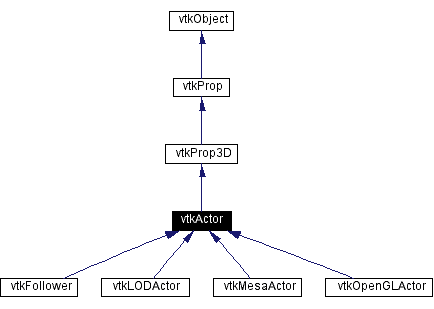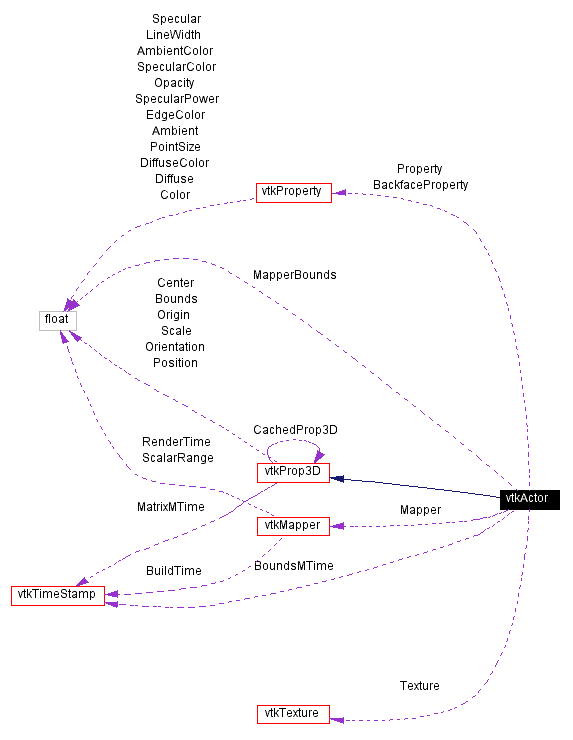
#include <vtkActor.h>
Inheritance diagram for vtkActor:


vtkActor is used to represent an entity in a rendering scene. It inherits functions related to the actors position, and orientation from vtkProp. The actor also has scaling and maintains a reference to the defining geometry (i.e., the mapper), rendering properties, and possibly a texture map. vtkActor combines these instance variables into one 4x4 transformation matrix as follows: [x y z 1] = [x y z 1] Translate(-origin) Scale(scale) Rot(y) Rot(x) Rot (z) Trans(origin) Trans(position)
Definition at line 77 of file vtkActor.h.
|
|
|
|
|
|
|
|
Return the class name as a string. This method is defined in all subclasses of vtkObject with the vtkTypeMacro found in vtkSetGet.h. Reimplemented from vtkProp3D. Reimplemented in vtkFollower, vtkLODActor, vtkMesaActor, and vtkOpenGLActor. |
|
|
Return 1 if this class type is the same type of (or a subclass of) the named class. Returns 0 otherwise. This method works in combination with vtkTypeMacro found in vtkSetGet.h. Reimplemented from vtkProp3D. Reimplemented in vtkFollower, vtkLODActor, vtkMesaActor, and vtkOpenGLActor. |
|
|
Return 1 if this class is the same type of (or a subclass of) the named class. Returns 0 otherwise. This method works in combination with vtkTypeMacro found in vtkSetGet.h. Reimplemented from vtkProp3D. Reimplemented in vtkFollower, vtkLODActor, vtkMesaActor, and vtkOpenGLActor. |
|
|
Will cast the supplied object to vtkObject* is this is a safe operation (i.e., a safe downcast); otherwise NULL is returned. This method is defined in all subclasses of vtkObject with the vtkTypeMacro found in vtkSetGet.h. Reimplemented from vtkProp3D. Reimplemented in vtkFollower, vtkLODActor, vtkMesaActor, and vtkOpenGLActor. |
|
||||||||||||
|
Methods invoked by print to print information about the object including superclasses. Typically not called by the user (use Print() instead) but used in the hierarchical print process to combine the output of several classes. Reimplemented from vtkProp3D. Reimplemented in vtkFollower, and vtkLODActor. |
|
|
Creates an actor with the following defaults: origin(0,0,0) position=(0,0,0) scale=(1,1,1) visibility=1 pickable=1 dragable=1 orientation=(0,0,0). No user defined matrix and no texture map. Reimplemented from vtkProp. Reimplemented in vtkFollower, vtkLODActor, vtkMesaActor, and vtkOpenGLActor. |
|
|
For some exporters and other other operations we must be able to collect all the actors or volumes. These methods are used in that process. Reimplemented from vtkProp. |
|
|
Support the standard render methods. Reimplemented from vtkProp. Reimplemented in vtkFollower, and vtkLODActor. |
|
|
Support the standard render methods. Reimplemented from vtkProp. Reimplemented in vtkFollower. |
|
||||||||||||
|
This causes the actor to be rendered. It in turn will render the actor's property, texture map and then mapper. If a property hasn't been assigned, then the actor will create one automatically. Note that a side effect of this method is that the pipeline will be updated. Reimplemented in vtkLODActor, vtkMesaActor, and vtkOpenGLActor. Definition at line 104 of file vtkActor.h. |
|
|
Shallow copy of an actor. Overloads the virtual vtkProp method. Reimplemented from vtkProp3D. Reimplemented in vtkFollower, and vtkLODActor. |
|
|
Release any graphics resources that are being consumed by this actor. The parameter window could be used to determine which graphic resources to release. Reimplemented from vtkProp. Reimplemented in vtkLODActor. |
|
|
Set/Get the property object that controls this actors surface properties. This should be an instance of a vtkProperty object. Every actor must have a property associated with it. If one isn't specified, then one will be generated automatically. Multiple actors can share one property object. |
|
|
Set/Get the property object that controls this actors surface properties. This should be an instance of a vtkProperty object. Every actor must have a property associated with it. If one isn't specified, then one will be generated automatically. Multiple actors can share one property object. |
|
|
Create a new property sutible for use with this type of Actor. For example, a vtkMesaActor should create a vtkMesaProperty in this function. The default is to just call vtkProperty::New. Reimplemented in vtkMesaActor. |
|
|
Set/Get the property object that controls this actors backface surface properties. This should be an instance of a vtkProperty object. If one isn't specified, then the front face properties will be used. Multiple actors can share one property object. |
|
|
Set/Get the property object that controls this actors backface surface properties. This should be an instance of a vtkProperty object. If one isn't specified, then the front face properties will be used. Multiple actors can share one property object. |
|
|
Set/Get the texture object to control rendering texture maps. This will be a vtkTexture object. An actor does not need to have an associated texture map and multiple actors can share one texture. |
|
|
Set/Get the texture object to control rendering texture maps. This will be a vtkTexture object. An actor does not need to have an associated texture map and multiple actors can share one texture. |
|
|
This is the method that is used to connect an actor to the end of a visualization pipeline, i.e. the mapper. This should be a subclass of vtkMapper. Typically vtkPolyDataMapper and vtkDataSetMapper will be used. |
|
|
Returns the Mapper that this actor is getting its data from. |
|
|
Get the bounds for this Actor as (Xmin,Xmax,Ymin,Ymax,Zmin,Zmax). (The method GetBounds(float bounds[6]) is available from the superclass.) Reimplemented from vtkProp3D. Definition at line 163 of file vtkActor.h. |
|
|
Get the bounds for this Actor as (Xmin,Xmax,Ymin,Ymax,Zmin,Zmax). (The method GetBounds(float bounds[6]) is available from the superclass.) Reimplemented from vtkProp3D. |
|
|
Apply the current properties to all parts that compose this actor. This method is overloaded in vtkAssembly to apply the assemblies' properties to all its parts in a recursive manner. Typically the use of this method is to set the desired properties in the assembly, and then push the properties down to the assemblies parts with ApplyProperties(). Definition at line 173 of file vtkActor.h. |
|
|
Get the actors mtime plus consider its properties, texture and usermatrix if set. Reimplemented from vtkObject. |
|
|
Return the mtime of anything that would cause the rendered image to appear differently. Usually this involves checking the mtime of the prop plus anything else it depends on such as properties, textures etc. Reimplemented from vtkProp. |
|
|
The following methods are for compatibility. The methods will be deprecated in the near future. Use vtkProp::GetNextPath() (and related functionality) to get the parts in an assembly (or more correctly, the paths in the assembly). |
|
|
The following methods are for compatibility. The methods will be deprecated in the near future. Use vtkProp::GetNextPath() (and related functionality) to get the parts in an assembly (or more correctly, the paths in the assembly). |
|
|
The following methods are for compatibility. The methods will be deprecated in the near future. Use vtkProp::GetNextPath() (and related functionality) to get the parts in an assembly (or more correctly, the paths in the assembly). |
|
|
|
|
|
Definition at line 199 of file vtkActor.h. |
|
|
Definition at line 200 of file vtkActor.h. |
|
|
Definition at line 201 of file vtkActor.h. |
|
|
Definition at line 202 of file vtkActor.h. |
|
|
Definition at line 209 of file vtkActor.h. |
|
|
Definition at line 210 of file vtkActor.h. |
 1.2.11.1 written by Dimitri van Heesch,
© 1997-2001
1.2.11.1 written by Dimitri van Heesch,
© 1997-2001